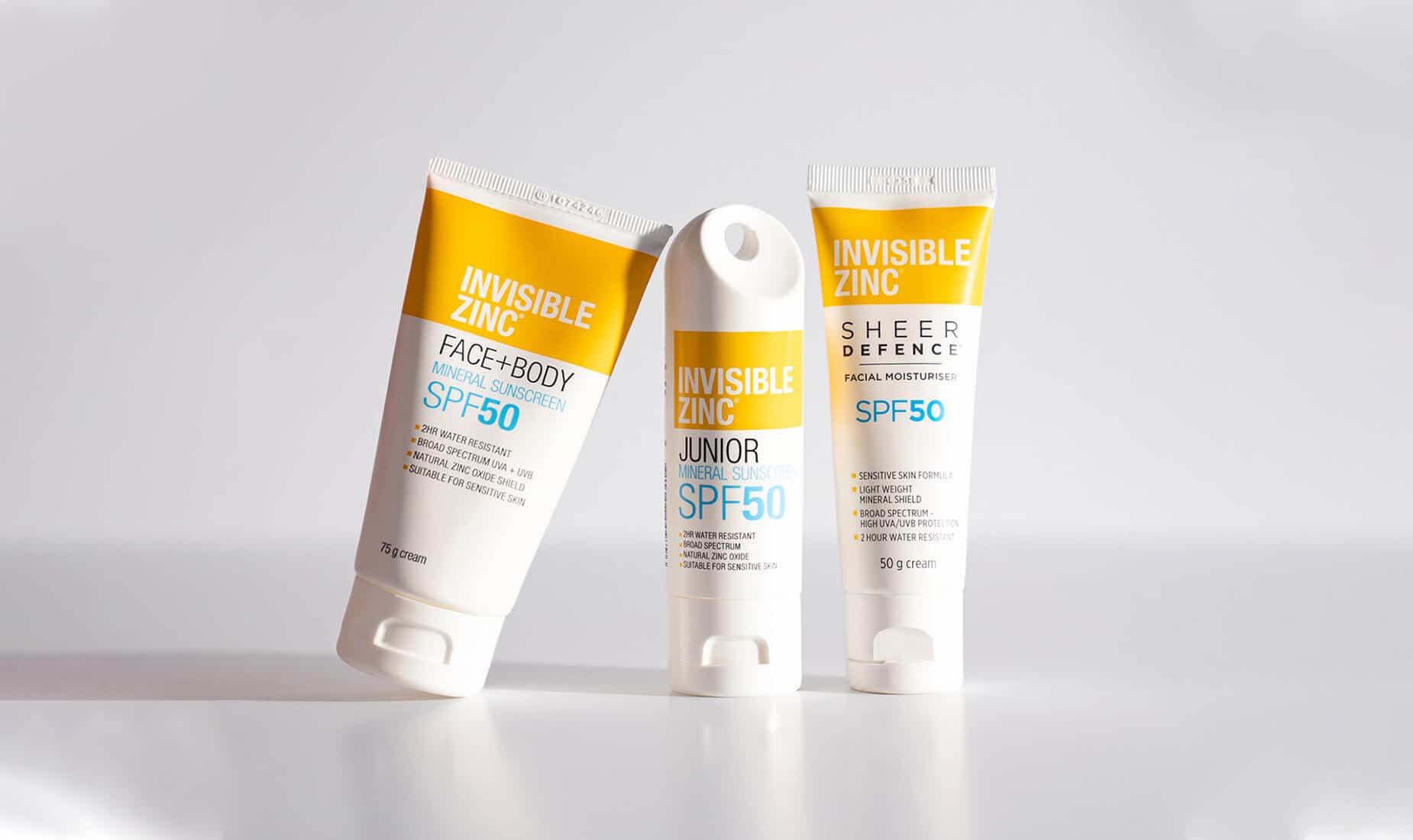

ZINC SUNSCREEN
Zinc Oxide is a mineral reflector that creates a physical, reflective barrier on the surface of your skin. In sunscreen, Zinc Oxide acts as a filter for UV radiation.
What is zinc oxide?
The key active ingredient in zinc sunscreen is zinc oxide. Zinc oxide is a naturally-occuring mineral found in the environment. In its natural state, it is a white powder that does not readily dissolve in water.
Zinc oxide possesses soothing and protective properties, which is why it has been used as a key ingredient in a wide range of skin care products for decades. You may well be familiar with one of its most common uses – zinc oxide is often used as a key ingredient in ointments and lotions that help to prevent nappy rash. It works by forming a physical barrier over the skin to help prevent irritation, allowing damaged skin to heal.
Another important property of zinc oxide is its ability to act as an effective filter for ultraviolet (UV) radiation – leading to its widespread use as a key active ingredient in sunscreen.
How does zinc oxide work in sunscreen?
To understand exactly how zinc oxide sunscreen works, let’s take a minute to review UV radiation and how it can affect our skin.
Radiation emitted from the sun occurs across a spectrum of light that includes infrared, visible light, and UV light. UV radiation is not visible to the naked eye and occurs at wavelengths measuring 200 to 400 nanometers (nm). The UV spectrum is divided into UVB radiation (290–320 nm) and UVA radiation (320–400 nm), with UVA radiation further categorised as UVA1 (340–400 nm) and UVA2 (320–340 nm).
When UV radiation reaches unprotected and exposed skin, it can cause damage to the cells in our skin. This damage results in visible effects such as sunburn as well as less obvious effects to the deeper skin cells that can lead to wrinkles and other signs of aging, and can increase our risk for developing skin cancer.
In sunscreen, zinc oxide acts as a filter for UV radiation. It works by forming a protective physical barrier on the surface of the skin, reflecting and scattering UV radiation. Zinc oxide can also protect the skin by absorbing some UV radiation.
Benefits of zinc sunscreen
In Australia, all sunscreens must meet certain standards and so are effective for protecting your skin when used correctly. But what makes zinc oxide sunscreen special?
Firstly, because zinc-based sunscreen contains a mineral-based physical UV filter rather than a chemical UV filter, it is less likely to penetrate through the outermost layer of your skin (called the stratum corneum) and reach the living cells in the skin’s epidermis. This makes zinc sunscreen suitable for use on even sensitive or dry skin, because there is minimal risk of the zinc oxide being absorbed or causing irritation.
Like most sunscreens available in Australia, zinc sunscreen offers broad spectrum coverage – this means it protects against both UVB and UVA radiation. However, zinc oxide is the only mineral UV filter that offers coverage for UVA1 radiation in addition to UVA2 and UVB. Most chemical UV filters also lack this UVA1 coverage and are often used in combinations with another chemical UV filter or even a physical UV filter to gain broad spectrum coverage.
Broad spectrum coverage is essential because UVB and UVA radiation cause damage in different ways. UVB radiation is the culprit that causes sunburn, directly damaging the cells at the surface of your skin. UVA radiation penetrates into the deeper layers of your skin, causing damage to cells that results in signs of aging such as wrinkles. UVA1 radiation has recently been identified as a key player in this aging process. Importantly, short-term and long-term exposure to both UVB and UVA radiation are associated with the development of skin cancers.
When it comes to choosing a zinc sunscreen, INVISIBLE ZINC has you covered, literally. INVISIBLE ZINC products use micronised zinc oxide – smaller particles of zinc oxide that offer the same great broad spectrum UV protection without the thick white look we remember from our childhoods. INVISIBLE ZINC contains just the single mineral-based physical UV filter to offer broad spectrum coverage without the need for added chemical UV filters. From everyday wear to active water-resistant sunscreen options, INVISIBLE ZINC has a product to suit all your needs.
Zinc sunscreen FAQs
Like all sunscreens, you should apply a generous amount of zinc oxide sunscreen to all areas of exposed skin 20 minutes before you plan to go out and about. Remember to reapply zinc sunscreen regularly – at least every 2 hours or after you go swimming, sweat a lot, or dry off with a towel.
In sunscreen, zinc oxide blocks UV radiation from reaching the surface of your skin. It protects the skin by forming a physical barrier that reflects and scatters UV radiation.
When used correctly, sunscreen containing zinc oxide offers effective broad spectrum coverage to protect your skin against damage from UVA1, UVA2, and UVB radiation.